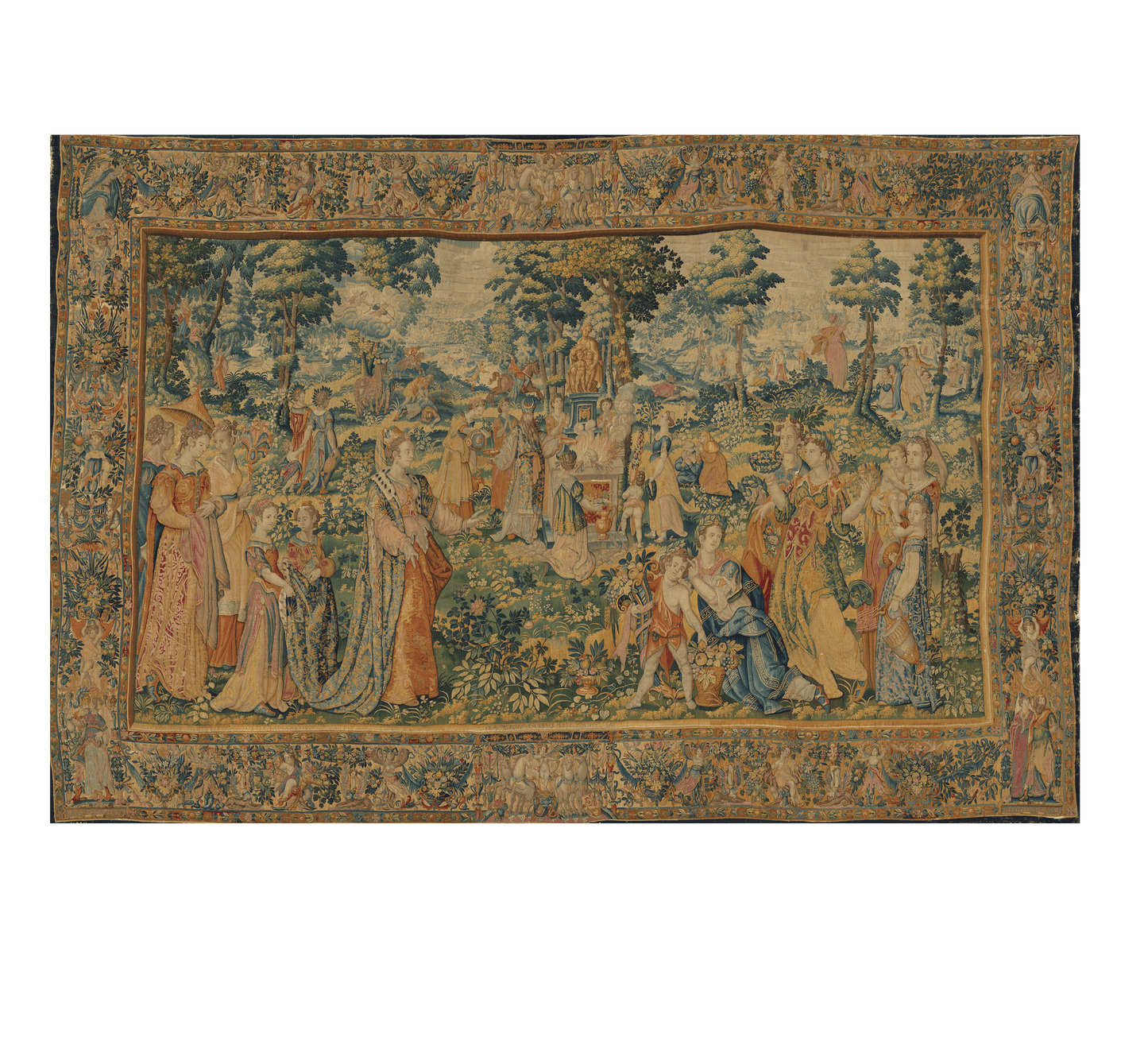Romantic English
The Festival of Flora: A Celebration of Spring RE089947
The Festival of Flora: A Celebration of Spring RE089947
Couldn't load pickup availability
Ah, what a splendid and vibrant scene unfolds before us! This tapestry is a true celebration of festivity and nature, a visual symphony where the harmony of human joy and the beauty of the natural world are woven together with exquisite artistry. Allow me to guide you through this tapestry, as we explore its many figures, motifs, and the story it so vividly tells.
Title: "The Festival of Flora: A Celebration of Spring"
Foreground and Main Scene: At the heart of this tapestry, we find a lively scene of celebration, most likely dedicated to Flora, the Roman goddess of flowers and spring. The tapestry bursts with color, movement, and joy, capturing a moment of communal festivity in a lush, verdant setting. The central figures are elegantly dressed women, perhaps personifications of the seasons or the attendants of Flora herself, each adorned in flowing gowns that ripple like the petals of flowers in a gentle breeze.
In the center of the composition, a noble figure, possibly the goddess Flora, stands gracefully. She is crowned with a garland of flowers and holds a bouquet in one hand, as if bestowing the blessings of spring upon the gathered celebrants. Her expression is serene and benevolent, embodying the rejuvenation and beauty that spring brings to the world.
Around her, a group of attendants, both men and women, are engaged in various activities. Some are dancing, their movements light and carefree, while others offer gifts—baskets overflowing with flowers, fruits, and garlands. The tapestry captures these figures in mid-action, their bodies elegantly curved and draped in rich fabrics, their faces animated with joy and reverence.
Background and Setting: The background is a lush, idealized landscape, typical of the Arcadian settings favored in Renaissance and Baroque tapestries. The scene is set in a verdant meadow, dotted with a variety of flowers and flanked by tall, leafy trees that create a natural frame around the central action. The trees are depicted with delicate detail, their branches laden with blossoms and fruit, further emphasizing the theme of abundance and renewal.
In the distance, we see more figures, likely villagers or shepherds, who are also partaking in the festivities. They are depicted smaller in scale, creating a sense of depth and drawing the viewer’s eye deeper into the tapestry. Among them, a statue of a deity, perhaps another representation of Flora or a related figure, stands on a pedestal surrounded by offerings—votive flames and garlands, suggesting a ritualistic homage.
Further back, the landscape stretches into rolling hills and perhaps even the faint outlines of classical ruins, which would situate this scene in an idealized, timeless past. The sky above is a soft blue, with a few wispy clouds, evoking a perfect spring day.
Symbolism and Allegory: This tapestry is rich with symbolism. Flora, the goddess of flowers and spring, is the embodiment of nature’s renewal and the fertility of the earth. The flowers, fruits, and garlands offered by her attendants symbolize the bounty of the season and the joy that comes with the return of life after the barren winter months.
The dancing figures represent the lightness and joy of the season, while the presence of classical ruins in the background may hint at the timelessness of these celebrations, connecting the past with the present and suggesting that the rites of spring are as old as civilization itself.
Border: The border of the tapestry is an intricate work of art in its own right, filled with floral motifs, intertwined vines, and possibly small figures representing putti, the cherubic beings often associated with love and playfulness. The border is rich in detail, with animals, flowers, and fruits, all of which reinforce the central theme of fertility and abundance. The colors are vibrant—reds, golds, and greens—creating a frame that both contains and complements the lively scene within.
Color and Technique: The colors are vibrant and varied, with a palette that includes rich reds, deep blues, soft pinks, and verdant greens. The tapestry glows with life, as if capturing the very essence of spring in its threads. The figures are rendered with a delicate touch, their clothing and expressions detailed with care and precision.
The weaving technique is superb, likely the work of a renowned European workshop—possibly from the Flemish or French traditions, where such elaborate tapestries were highly valued. The texture of the fabrics, the sheen of the silk, and the play of light and shadow are all depicted with a mastery that brings the scene to life.
Interpretation: "The Festival of Flora" is a tapestry that celebrates the joy of life, the beauty of nature, and the renewal of the earth. It is a visual ode to spring, capturing the moment when the world is reborn in color and light. The tapestry would have been a symbol of wealth and culture, likely hanging in a grand hall where it could be admired for both its artistic merit and the festive atmosphere it conveyed.
"The Festival of Flora" is a tapestry that embodies the spirit of celebration and the eternal cycle of nature. It invites the viewer to partake in the joyous rites of spring, to revel in the beauty of the natural world, and to appreciate the harmony between humanity and the earth. This tapestry is not just a decorative piece but a celebration of life itself, woven into every thread.
RE089947


